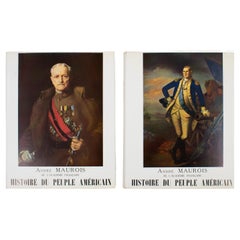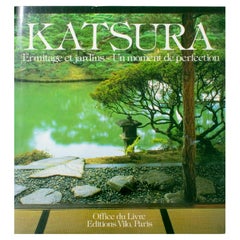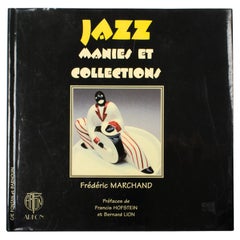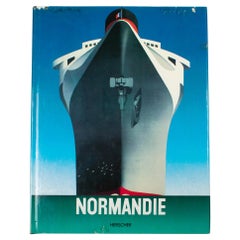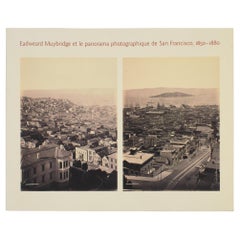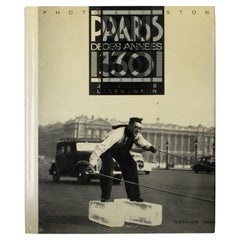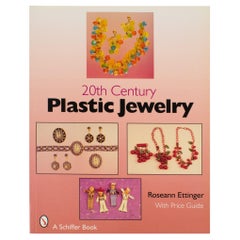Modern History Furniture
Vintage 1950s French Modern Books
Paper
Vintage 1980s French Modern Books
Paper
1990s French Modern Books
Paper
Vintage 1970s French Modern Books
Paper
Vintage 1980s French Modern Books
Paper
Early 2000s French Modern Books
Paper
1990s Canadian Modern Books
Paper
Vintage 1980s French Modern Books
Paper
Early 2000s American Modern Books
Paper
Early 2000s French Modern Books
Paper
Vintage 1980s French Modern Books
Paper
Vintage 1980s French Modern Books
Paper
Vintage 1980s French Modern Books
Paper
Vintage 1960s French Modern Books
Paper
1990s French Modern Books
Paper
Vintage 1960s American Modern Books
Paper
Early 2000s American Modern Books
Paper
Vintage 1980s American Modern Books
Paper
Vintage 1960s American Modern Books
Paper
Early 2000s French Art Deco Books
Paper
20th Century Books
Paper
21st Century and Contemporary Books
Paper
Vintage 1980s French Modern Books
Paper
Antique Early 1900s American Organic Modern Natural Specimens
Shell
Vintage 1940s American Organic Modern Desk Sets
Shell
Early 2000s American Mid-Century Modern Books
Paper
2010s Czech Post-Modern Vases
Glass
2010s Czech Post-Modern Vases
Glass
2010s Czech Post-Modern Vases
Glass
2010s Czech Post-Modern Vases
Glass
2010s Czech Post-Modern Vases
Glass
2010s Czech Post-Modern Vases
Glass
Late 20th Century American Mid-Century Modern Books
Paper
Vintage 1950s Spanish Mid-Century Modern Decorative Art
Metal
2010s Czech Post-Modern Vases
Glass
2010s Czech Post-Modern Vases
Glass
2010s Czech Post-Modern Vases
Glass
2010s Czech Post-Modern Vases
Glass
2010s Czech Post-Modern Vases
Glass
Late 20th Century English Post-Modern Abstract Sculptures
Earthenware
2010s American Mid-Century Modern Architectural Elements
Brass, Stainless Steel
2010s American Mid-Century Modern Architectural Elements
Brass, Stainless Steel
2010s American Mid-Century Modern Architectural Elements
Brass, Stainless Steel
2010s American Mid-Century Modern Architectural Elements
Brass, Stainless Steel
2010s American Modern Natural Specimens
Brass
Vintage 1980s Oceanic Modern Posters
Paper
2010s American Modern Architectural Elements
Aluminum
Late 20th Century American Organic Modern Books
Paper
Mid-20th Century Swiss Mid-Century Modern Posters
Paper
Vintage 1980s English Post-Modern Desks
Giltwood, Mahogany
21st Century and Contemporary English Post-Modern Books
Paper
Mid-20th Century American Modern Books
Cotton, Paper
Early 2000s American Mid-Century Modern Books
Paper
20th Century American Modern Books
Paper
20th Century American Modern Books
Paper
2010s American Mid-Century Modern Doors and Gates
Walnut, Ash, Oak, Rosewood, Teak
2010s American Mid-Century Modern Doors and Gates
Brass
2010s American Mid-Century Modern Doors and Gates
Brass
- 1
Modern History Furniture For Sale on 1stDibs
How Much is a Modern History Furniture?
- 1stDibs ExpertMay 14, 2024The history of Martinsville furniture starts with the founding of the company in Martinsville, Virginia, in 1906 by Ancil Witten and Charles Keesee, a pair of former tobacco farmers. They launched their business with $30,000 in capital and began to manufacture bedroom furniture under the name American Furniture Company. In the 1920s, American Furniture Company expanded its offerings from bedroom furnishings with a range of dining room sets. By the 1950s, the company’s name had been changed to American of Martinsville, and it had gained a reputation for exquisite craftsmanship as well as a variety of furniture styles. Inspired by designers like George Nakashima and Paul László, the brand innovated with wood. Merton Gershun was one of the company's most prolific designers, and he was responsible for some of its most successful modern furniture lines using the richer, darker woods that would become emblematic of mid-century furniture. Gershun's most popular line was Dania, with its sleek walnut credenzas fitted with stylish brass accents and large drawers. Today, American of Martinsville specializes in furniture for the healthcare and hospitality industries. Find a variety of American of Martinsville furniture on 1stDibs.
- 1stDibs ExpertOctober 24, 2024The history of Kartell furniture begins with Italian chemical engineer Giulio Castelli and his wife, Anna Ferrieri. They founded the company in 1949 as an industrial design firm, producing items like ski racks for automobiles and laboratory equipment designed to replace breakable glass with sturdy plastic. They launched a housewares division of Kartell in 1953, making lighting fixtures, kitchen tools and accessories from colorful molded plastic. The affordability and infinite range of styles and hues won devotees of Kartell’s ingenious designs for juicers, dustpans and dish racks. Kartell designer Gino Colombini was responsible for many of these early products, including the KS 1146 Bucket, which won the Compasso d’Oro prize in 1955. Buoyed by its success in the home goods market, Kartell introduced its Habitat division in 1963. In 1972, Kartell achieved international recognition for its innovative work when a landmark exhibition curated by Emilio Ambasz called “Italy: The New Domestic Landscape” opened at New York’s Museum of Modern Art. In 1988, Castelli and Ferrieri sold Kartell to Claudio Luti, their son-in-law, who has expanded the company’s roster of designers. Shop a collection of Kartell furniture on 1stDibs.
- What is Danish modern furniture?1 Answer1stDibs ExpertFebruary 13, 2024Danish modern furniture is the term for a style of furniture that emerged during the 1930s through the innovation of designers from Denmark. It is a subset of Scandinavian modern furniture, the warmest and most organic iteration of modernist design. The work of the designers associated with vintage Scandinavian modern furniture was founded on centuries-old beliefs in both quality craftsmanship and the ideal that beauty should enhance even the humblest accessories of daily life. Some notable Danish modern designers include Hans J. Wegner, Kaare Klint, Arne Jacobsen, Finn Juhl, Arne Vodder and Verner Panton. Shop a range of Danish modern furniture on 1stDibs.
- 1stDibs ExpertAugust 8, 2024Modern furniture is made of many different types of materials. Some modern furniture makers used natural materials like wood for frames and leather and linen for upholstery. Metals, such as aluminum, stainless steel and nickel, were also common, as were some plastics. Explore a diverse assortment of modern furniture from some of the world’s top sellers on 1stDibs.
- What is modern furniture design?1 Answer1stDibs ExpertAugust 8, 2024Modern furniture design is an overarching term for the new approach that designers began taking in the early 20th century. Many experts cite the Bauhaus movement as the start of the modern era. Its style was defined by the instructors and students at a progressive German art and design school founded by the architect Walter Gropius that operated from 1919 to 1933. In Bauhaus-style furniture, the school’s followers married industrial and natural materials in simple, geometric forms. The goal of the Bauhaus was to erase the distinction between art and craft while embracing the use of new technologies and materials. As the Bauhaus movement was emerging, so too was Art Deco. This iconic movement made an indelible mark on all fields of design throughout the 1920s and ’30s, celebrating society’s growing industrialization with refined elegance and stunning craftsmanship. Art Deco furniture makers respected the dark woods and modern metals with which they worked; they frequently incorporated decorative embellishments such as exotic animal hides as well as veneers in their seating, case pieces, living room sets and bedroom furniture. After World War II, modern design continued with the mid-century modern movement. The style is characterized by pieces that were conceived and made in an energetic, optimistic spirit by creators who believed that good design was an essential part of good living. Historians typically say that the modern approach to furniture design ended in the mid-1960s or early 1970s. Pieces made after that time may be called postmodern or contemporary. Shop a large collection of modern furniture on 1stDibs.
- What is modern style furniture?1 Answer1stDibs ExpertFebruary 22, 2021Modern style furniture has smooth shiny surfaces, straight lines, simple shapes. The general objective is a simple uncluttered look.
- 1stDibs ExpertOctober 7, 2024The difference between modern furniture and old furniture is in the specificity of the term. Generally, pieces considered modern date from between the end of World War II in 1945 and the end of the 1970s. During this period, more furniture makers mass produced pieces, and designers increasingly used new materials, such as plywood and plastic. Old furniture is not a specific term. People frequently use the term old for anything that subjectively appears aged. Explore a large selection of modern furniture on 1stDibs.
- 1stDibs ExpertMay 22, 2019
Mid-century modernism first appeared in 1945 and merged a minimalist aesthetic with practicality. Mid-century modern furniture is distinguishable by its lack of decoration or extravagance and its use of clean lines, organic curves and variety of natural materials.
1stDibs ExpertFebruary 22, 2021Mid century modern furniture refers to pieces designed during the middle of the 20th century — specifically 1930s through the mid-1960s. This period represents a design and architecture movement characterized by simple shapes, clean lines, and organic materials. Some of the most famous mid century modern designers include Ray Eames, Charlotte Perriand, Isamu Noguchi and Eero Saarinen. - 1stDibs ExpertApril 22, 2024There is not a single year that is mid-century modern. The style emerged during the 1940s and 1950s and remained dominant through the 1960s and into the early 1970s. Some notable designers who contributed to the development of the mid-century modern style include Charles and Ray Eames, Eero Saarinen, Milo Baughman, Florence Knoll, Harry Bertoia, Isamu Noguchi and George Nelson. Shop a wide range of mid-century modern furniture on 1stDibs.
- 1stDibs ExpertFebruary 13, 2024Mid-century modern furniture is so popular largely because its characteristics align well with the trends and tastes that are dominant today. Many people love its simple look defined by clean lines, and the use of natural materials also adds to its popularity. In addition, designers created mid-century modern furniture to be as functional as it is visually appealing, making pieces executed in the style simple, convenient and comfortable to use. Find a wide range of mid-century modern furniture on 1stDibs.
- 1stDibs ExpertSeptember 25, 2019
Mid-century modern furniture combines sleek lines with organic shapes.
- 1stDibs ExpertSeptember 25, 2019
Some of the most famous mid-century modern furniture designers were Alvar Aalto, Charles and Ray Eames, Paul Evans, Poul Kjærholm, Florence Knoll, George Nakashima, Giò Ponti, Hans Wegner, Charlotte Perriand, Sergio Rodrigues and Eero Saarinen.
- 1stDibs ExpertMarch 22, 2022Marcel Breuer introduced the material of tubular steel to modern furniture design. He employed it in many of his chairs, tables and sofas, prizing the material because it minimized the weight of pieces without sacrificing their strength. Shop a range of Marcel Breuer furniture on 1stDibs.
